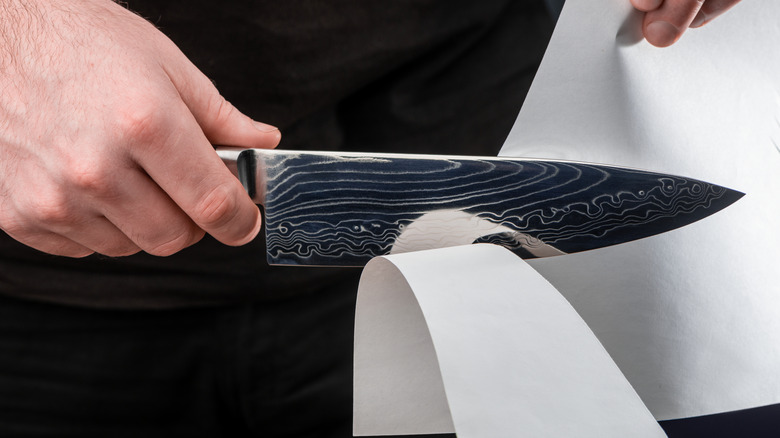This Taiwanese Family Business Is Turning Artillery Shells Into Knives
Quirky kitchen gadgets are everywhere these days, from knives that allow you to pre-shred butter so it is easier to spread, to stainless steel slicers that let you cut watermelon in a fuss-free way, per Good Housekeeping. Yet, as any foodie or professional chef will tell you, there is nothing as valuable as a sharp, straightforward kitchen knife, simply because as chef Dennis Prescott tells NBC, "You'll pick one up literally every time you cook."
The most common metal knives on the market today are made with a handful of materials. At the lower end of the range is carbon steel, which, per Kitchen Rank, is literally a mix of iron and carbon. The site says this type of knife is popular because it is "cheaper but steady and durable." One downside: carbon steel adversely reacts to acidic foods, eggs, and onions, and the material is prone to rust and corrosion — particularly if it isn't well cared for. Then there is the stainless steel knife which doesn't rust as easily, but doesn't stay sharp for very long.
At the top of the metal knife hierarchy are titanium knives and high carbon stainless steel, materials which can resist pretty much anything you throw at them, from rust to acidic foods. They are durable and can stay sharp — but prepare to pay top dollar for knives made with these materials, because they don't come cheap.
Repurposing heavy artillery
We're not entirely sure what kind of steel was used to forge early 20th-century artillery shells, but what we do know is that over a period of decades beginning in 1953, hundreds and thousands of artillery shells turned up on Taiwan's offshore island of Kinmen, thanks to a relentless bombardment that went on for decades, per Taiwan Today. We also know that a good percentage of these shells have passed through Maestro Wu's foundry, where patriarch Wu Tseng-dong has been collecting shells and recycling the material to make a range of kitchen knives and farming tools, per Kinmen.
The Wus have been salvaging military-grade scrap metal to make knives for decades. The family set up its business in 1937 as a way of augmenting their income as a farming family. Their early tools were made out of ready-made steel, but that changed after the Second World War, as Wu told CNN: "In the old days, steel was scarce in Kinmen. We felt we could recycle the shells and turn them into something useful."
And when the shelling started, the Wus found themselves with hundreds and thousands of scrap artillery shells to refashion into kitchen and farming tools, per YouTube – an act which Wu refers to as a "gift from the skies," via Kinmen.
There are still plenty of undiscovered artillery shells
On average, Maestro Wu can create 60 steel blades from one artillery shell, and all are forged and sharpened by hand (via YouTube). Wu tells CNN they began by making knives to use at home, but when outside demand picked up, they began to expand the business. "The Taiwanese soldiers gave us a lot of ideas to turn the knives into souvenirs. We worked to raise their commemorative value, and slowly the knives became more artistic and pleasing to the eye."
And while they make different types of knives, it is Master Wu's kitchen knives that continue to get the most attention — he's even found importers to bring the knives into the United States to sell. Among the knives on offer are a number of particularly lethal-looking Chinese cleavers and fish knives, per Yun Hai.
With all the recycling that's been going on, it would be easy to think that Kinmen might not have many shells left to uncover, but that doesn't appear to be the case at all. "Not all the shells have been collected yet. Many of those shells contained propaganda leaflets, and they did not explode. So many are still buried underground, and shells can still be dug up by construction workers," Wu told CNN, which means there will still be knives to go around for souvenir hunters for some time to come.


